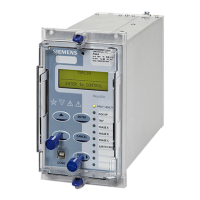7SR11 & 7SR12 Description Of Operation
Chapter 1 Page 28 of 88 ©2017 Siemens Protection Devices Limited
2.11 Self Monitoring
The relay incorporates a number of self-monitoring features. Each of these features can initiate a controlled reset
recovery sequence.
Supervision includes a power supply watchdog, code execution watchdog, memory checks by checksum and
processor/ADC health checks. When all checks indicate the relay is operating correctly the ‘Protection Healthy’
LED is illuminated.
If an internal failure is detected, a message will be displayed. The relay will reset in an attempt to rectify the
failure. This will result in de-energisation of any binary output mapped to ‘protection healthy’ and flashing of the
protection healthy LED. If a successful reset is achieved by the relay the LED and output contact will revert back
to normal operational mode, and the relay will restart, therefore ensuring the circuit is protected for the maximum
time.
A Start-up Counter Meter is provided to display the number of start-ups the relay has performed. Once the
number of start-ups has exceeded a set number, an Alarm output can be given.
--------------------
|Start Alarm |
|Count 1|
|Target 100|
| |
--------------------
Figure 2-12 Start-up Counter Meter
Reset of the counter can be done from the meter or via a binary input or a command.
Various types of start-up are monitored by the relay:
1. power-on starts
2. expected starts (user initiated via comms)
3. unexpected starts (caused by the relay watchdog)
Any combination of these can be selected for the start-up count. This is done in the MAINTENANCE
MENU>START COUNT menu using the Start Up Types setting. All the start-up types selected (ticked) will be
added to the overall start-up count.
The number of restarts before the alarm output is raised is set in the MAINTENANCE MENU>START COUNT
menu using the Start Up Count Target setting.
When the number of relay start-ups reaches the target value an output is raised, OUTPUT MATRIX>Start Up
Count Alarm, which can be programmed to any combination of binary outputs, LED’s or virtual outputs.
The following screen-shot shows the events which are generated when the relay re-starts. The highlighted events
show the cause of the re-start. The event which comes next shows the type of restart followed by the relay:
Warm, Cold or Re-Start.
As a further safeguard, if the Relay performs a number of unexpected starts SYSTEM CONFIG>Unexpected
Restart Count in a given time SYSTEM CONFIG>Unexpected Restart Period, it can be configured using the
SYSTEM CONFIG>Unexpected Restart Blocking setting to remove itself from service. In this case the Relay
will display an error message:
--------------------
|UNEXPECTED RESTART |
|COUNTS EXCEEDED! |
|DEVICE LOCKED OUT |
| |
--------------------
Figure 2-13 Unexpected Restarts Lockout Text
And enter a locked-up mode. In this mode the Relay will disable operation of all LED’s and Binary Outputs,
including Protection Healthy, all pushbuttons and any data communications.
Once the Relay has failed in this manner, it is non-recoverable at site and must be returned to the manufacturer
for repair.

